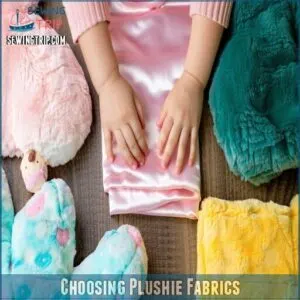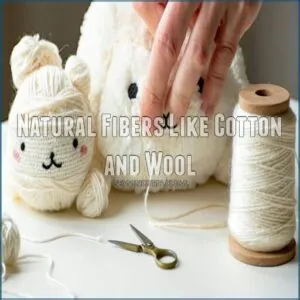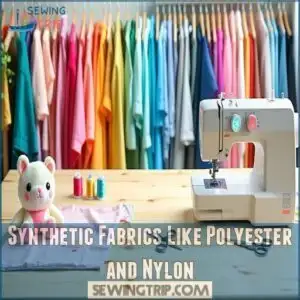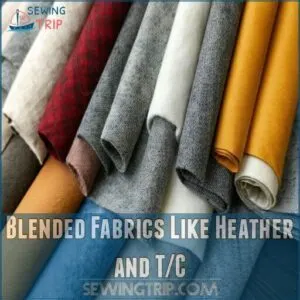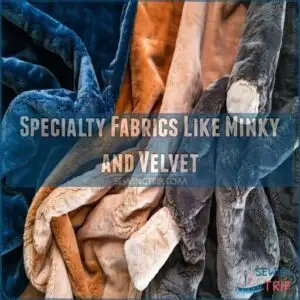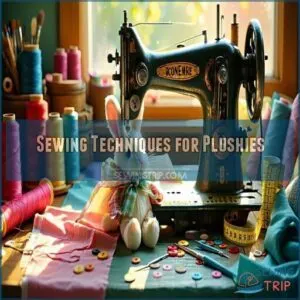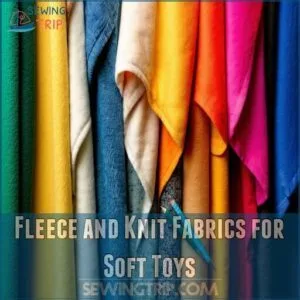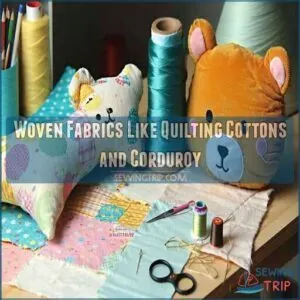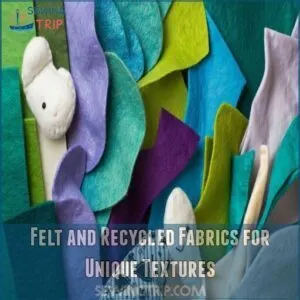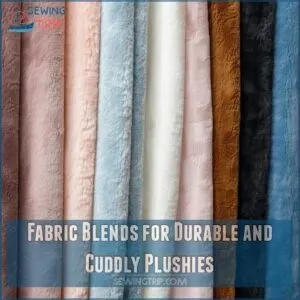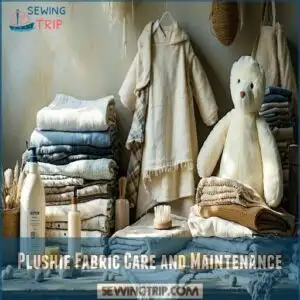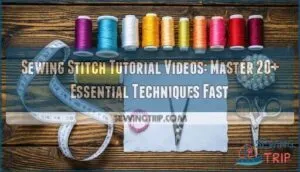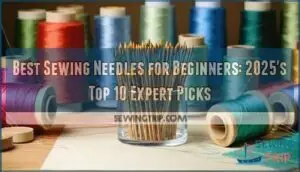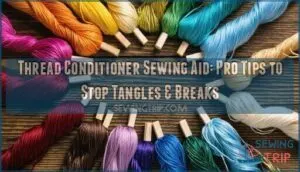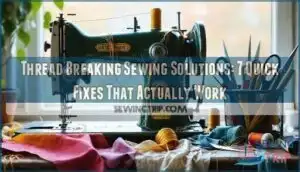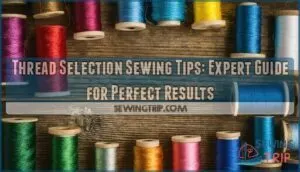This site is supported by our readers. We may earn a commission, at no cost to you, if you purchase through links.
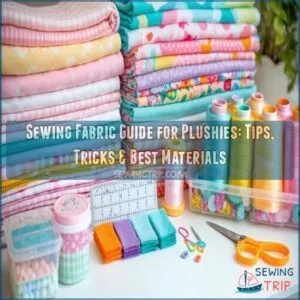 For plushie success, you’ll need the right fabric. Choose minky or fleece for softness, cotton for structure, and felt for details.
For plushie success, you’ll need the right fabric. Choose minky or fleece for softness, cotton for structure, and felt for details.
Pick machine-washable materials with tight weaves to prevent stuffing leaks. Avoid fabrics with stretch for beginners.
You’ll need a sharp needle (size 90/14) and polyester thread for durability. Cut with the nap direction consistent for uniform appearance.
Pre-wash fabrics to prevent shrinkage after completion. Remember to use a 1/4-inch seam allowance for small plushies.
The difference between a huggable friend and a misshapen blob often comes down to these fabric fundamentals.
Table Of Contents
Key Takeaways
- Choose your fabric based on purpose – minky and fleece for softness, cotton for structure, felt for details, with safety certifications to ensure your plushie is free from toxins and allergens.
- Use the right tools for professional results – you’ll need sharp fabric scissors, ballpoint needles (size 90/14), polyester thread for durability, and consider a walking foot to prevent fabric shifting.
- Follow proper sewing techniques – maintain a consistent 1/4-inch seam allowance for small plushies, use longer stitch lengths (3-4) to prevent bunching, and pre-wash your fabrics to prevent later shrinkage.
- Care properly for longevity – wash plushies gently with mild soap (by hand or in a mesh bag on gentle cycle), air dry flat to maintain shape, and store in cool, dark places to prevent color fading and pest damage.
Choosing Plushie Fabrics
Choosing the right fabric for your plushie is important for safety, durability, and comfort. You’ll want something soft, easy to clean, and safe for everyone to enjoy.
Safety Considerations
When choosing plushie fabric, safety comes first. Pick materials free from toxins and choking hazards. Verify that fabrics meet flammability standards and allergen control measures.
Remember to practice general sewing safety to avoid accidents.
Follow these five tips:
- Avoid harmful chemicals with fabric safety certifications.
- Use safe dyes that won’t irritate skin.
- Check for small, secure parts.
- Choose non-flammable fabrics.
- Confirm compliance with safety standards.
Durability Factors
When making plushies that last, durability becomes your top priority.
Look for fabrics with high tear resistance and good seam strength. Plush fabric quality varies widely, with higher fiber quality generally offering better abrasion resistance.
Check for pilling prevention properties, especially for toys that will see heavy handling.
Fabric durability depends on weave tightness and thickness.
Test fabric properties by stretching slightly—quality materials spring back without permanent deformation.
Comfort and Softness
When you hug a plushie, comfort and softness matter most.
The fabric feel affects the whole sensory experience. Minky and fleece offer excellent tactile qualities that kids and adults enjoy.
Look for plush fabric that keeps its softness retention after washing. The right plushie texture creates a comforting touch that makes your stuffed friend special.
Always test plushie fabric against your skin before buying.
Color Fastness
In regard to color fastness, your plushie fabric needs to maintain its vibrancy through time.
Look for fabrics with high-quality dye that won’t fade with sunlight exposure or wash resistance.
Good plushie materials prevent color bleeding onto other fabrics.
Check fabric treatment labels before buying.
Proper fabric selection makes your plushie stay bright and appealing even after multiple cleanings, making fabric quality a priority.
Allergy Prevention
While colors should stay bright in your plushie, safety matters more.
Hypoallergenic fabrics like organic cotton, bamboo, and polyester prevent allergic reactions when cuddled.
Look for OEKO-TEX certified materials that don’t contain harmful substances.
Tightly woven fabrics with pores smaller than 10 microns guard against dust mites.
Washable materials like interlock jersey let you clean away allergens regularly.
Your plushies will be safe for sensitive skin and allergy-prone kids.
Fabric Types and Properties
You’ll find various fabric types for plushies including cotton, polyester, wool, and specialty options like minky and velvet.
Each fabric has unique properties that affect durability, softness, and ease of sewing for your cuddly creations.
Natural Fibers Like Cotton and Wool
When choosing natural fibers for your plushies, cotton and wool offer unique benefits and challenges.
Cotton plushies provide excellent breathability but may wrinkle easily.
- Cotton is skin-friendly and biodegradable, making it an eco-friendly plush option
- Wool retains its shape well and offers natural durability
- Both materials require specific care, with wool potentially causing allergies in sensitive individuals
Many crafters appreciate natural fiber sourcing for sustainable projects.
Synthetic Fabrics Like Polyester and Nylon
Synthetic fabrics offer excellent options for your plushie projects.
Polyester delivers outstanding durability and easy cleaning, making it perfect for frequently-handled toys. Nylon provides strength but might absorb odors over time.
Both materials cost less than natural fibers while maintaining their shape better. Microfiber plush creates an ultra-soft texture that kids love.
These fabric types resist wrinkles and dry quickly after washing, saving you maintenance time and effort, which is a significant advantage of using synthetic fabrics like polyester.
Blended Fabrics Like Heather and T/C
While pure synthetic fabrics offer specific benefits, blended fabrics combine the best of multiple materials.
Heather and T/C (polyester-cotton) blends have become popular choices for plushie makers.
- T/C blends offer better durability than pure cotton
- Heather fabric creates unique textures your fingers can’t resist
- Cost-effective options save your craft budget
- Blends hold shape better during washing
- Less pilling means your plushies stay looking new longer, which is a key factor in their overall appearance.
Specialty Fabrics Like Minky and Velvet
Many specialty fabrics take plushie-making to the next level.
Minky and velvet are top choices for soft plush fabrics.
| Feature | Minky | Velvet |
|---|---|---|
| Texture | One-sided plush | Napped surface |
| Best Use | Baby items, toys | Textured plushies |
| Care | Attracts dust | Avoid crushing nap |
Both fabrics pose sewing challenges due to their slippery nature.
Minky properties include polyester construction and varying pile heights, while velvet applications shine where texture matters.
For increased durability, consider nylon upholstery options.
These fabrics can help take your plushie-making to the next level with the right sewing challenges in mind.
Sewing Techniques for Plushies
You’ll need special techniques to turn fabric into cute plushies that last. Using the right tools and methods will help you create stuffed animals with neat seams and professional results.
Essential Tools Like Rotary Cutters and Walking Feet
Now that you know about fabric types, let’s look at tools you’ll need.
Rotary cutters give smooth, precise cuts through plush fabric.
They work with acrylic rulers to make accurate seam allowances.
Walking feet stop fabric layers from shifting while you sew.
They’re helpful when working with thick plush materials, like using the right tools, such as sharp fabric scissors, is also essential for plushie projects.
Using the right tools, like sharp fabric scissors, is also essential for plushie projects.
Both tools will make your plushie-making easier and help create professional-looking results.
Pinning and Sewing Strategies
Now that you have your tools ready, let’s talk about pinning and sewing your plushie fabric.
Pin your fabric layers every 1-2 inches to prevent shifting. Use ballpoint needles (90/14 size) for plush materials to avoid snags.
Set your machine to longer stitch lengths (3-4) for better seam strength. When sewing, keep fabric alignment consistent and maintain a ½-inch seam allowance.
A walking foot helps control fuzz and guarantees even feeding of stretchy materials. For best results, consider using ballpoint needles specifically designed for plush fabrics.
Ironing and Pressing Methods
With delicate plush fabrics, careful ironing is a must.
Use low heat settings and always place a press cloth between the iron and fabric to protect texture.
For seam flattening, keep the iron moving to avoid crushing the pile.
Steam can help relax stubborn seams.
For specialized tools, consider plush ironing products.
Some fabrics like minky shouldn’t face direct heat – finger pressing works better for fabric preparation and texture preservation.
Seam Allowances and Stitch Lengths
When sewing plushies, proper seam allowances and stitch lengths are vital for durability. You’ll need slightly bigger seam allowances (½ inch) for plush fabrics to prevent fraying and guarantee strength.
For best results with plushie fabric:
- Use longer stitch lengths (3-4) to prevent fabric bunching
- Increase seam allowance for curved areas to reduce puckering
- Adjust settings based on fabric thickness – thicker fabrics need longer stitches, ensuring durability and preventing fraying.
Fabric Selection for Plushie Applications
You’ll need to pick the right fabric for your plushie project based on how it will be used and who’ll enjoy it.
Your choice affects safety, durability, comfort, and appearance, so consider materials like soft fleece for cuddly creatures or quilting cotton for detailed designs, which can impact the overall comfort.
Fleece and Knit Fabrics for Soft Toys
Now that you’ve mastered the basic sewing techniques, let’s look at your fabric options.
Fleece and knit fabrics are top choices for soft toys. Fleece offers excellent durability without fraying, making it perfect for beginners.
Knit fabric provides natural stretch that gives your plushies a huggable quality. When sewing knits, use ballpoint needles to prevent tears.
Both materials create cuddly results that children love to hold.
Woven Fabrics Like Quilting Cottons and Corduroy
While fleece offers stretch and softness, woven fabrics bring different benefits to your plushie projects.
Quilting cottons provide endless print options for unique toys, their tight weave gives good woven durability but lacks stretch.
Corduroy adds fun texture variety to your creations, remember that repurposed fabrics like old shirts or curtains work well too.
The main design limitation is that woven fabrics don’t give when stuffed, so allow extra seam allowance.
Felt and Recycled Fabrics for Unique Textures
While quilting cottons offer neat prints, felt and recycled fabrics bring unique textures to your plushie creations.
Felt comes in two main varieties:
- Wool felt – more durable but costs more
- Acrylic felt – budget-friendly but less sturdy
- Blended felt – middle-ground option
- Craft felt – perfect for small details like eyes
Repurposing old clothes creates one-of-a-kind plushies. Try making a Scrap Snake from fabric leftovers – it’s fun and reduces waste, using recycled fabrics and unique textures.
Fabric Blends for Durable and Cuddly Plushies
When you combine different fibers, you get the best of both worlds for your plushies.
Cotton-polyester blends offer durability without sacrificing softness.
Aim for blend ratios like 80/20 or 65/35 for ideal results.
These fabric blends withstand performance testing better than single-fiber options.
Cost analysis shows they’re cost-effective too.
For texture optimization, try fleece-minky combinations that create super cuddly plush fabric with improved fabric durability.
Plushie Fabric Care and Maintenance
You’ll need to care for your plushie fabrics properly to keep them looking fresh and cuddly for years to come.
Regular cleaning and smart storage will protect your fuzzy friends from dust, stains, and damage that can shorten their lifespan, ensuring they remain in good condition through proper care.
Cleaning and Washing Methods
Three simple steps will keep your plushie fabric fresh.
First, check care labels for washing instructions.
Most plush toys need hand washing with mild soap to protect fabric.
For machine-washable plushies, use cold water and gentle cycle in a mesh bag.
Spot cleaning works best for stain removal.
Always test cleaners on hidden areas to prevent fabric damage, following the gentle approach to cleaning.
Drying and Ironing Techniques
After washing, proper drying keeps your plushie fabrics in top shape.
Air dry most plush materials flat on a towel.
For fleece and cotton blends, use low heat in the dryer with a damp washcloth to reduce fuzz.
When ironing, use low heat settings and a press cloth to protect fabric texture.
Never iron directly on fur-like fabrics.
Steam works better than direct heat for wrinkle removal in sensitive materials.
Always remember that adjustable heat settings are essential for different fabrics, and using them correctly is crucial for maintaining the quality of your plushie fabrics, especially when dealing with sensitive materials and requiring proper drying.
Storage and Handling Tips
After your plushies are fully dry, proper storage keeps them looking their best.
Store fabric and finished plushies in cool, dark places to avoid sunlight exposure that fades colors.
Use bins with lids for pest prevention and humidity control.
When handling sewing fabric, keep hands clean and fold with tissue paper to maintain shape.
Fabric protectors can help repel dust on stored materials.
Never stack heavy items on plushies to prevent damage and ensure they remain in good condition, using proper storage techniques.
Repair and Restoration Strategies
After years of love, plushies often need a refresh. Check for loose parts, worn spots, and flattened stuffing before starting repairs.
Mend small rips with matching thread or fabric glue. Replace lost eyes with craft store alternatives. Add fresh stuffing through opened seams to restore plumpness.
Brush matted fur gently with a fine-toothed comb. Simple seam repair extends your plushie’s life considerably.
For more thorough fixes, consider using a plushie repair kit for various mending needs to make a thorough fix.
Frequently Asked Questions (FAQs)
What fabric should I use for making plushies?
For plushies, you’ll want to use minky, fleece, or cotton fabric. Minky offers durability and softness, fleece doesn’t fray and is beginner-friendly, while cotton works well for detailed designs.
What stitch to use when sewing plushies?
Like threading a needle through a dream, use a straight stitch at 3-4 length for your plushies.
You’ll want to add a zigzag stitch near edges for durability and to prevent fabric fraying.
What is the best thread for sewing plushies?
You’ll want polyester thread for your plushies.
It’s strong, flexible, and won’t break during play.
For thicker fabrics, try a heavier weight thread.
Always match your thread color to your fabric.
Can you sew plush fabric with a sewing machine?
Your sewing machine will tackle plush fabric like a champion.
You’ll need a ballpoint needle (90/14), longer stitch length (3-4), and a walking foot attachment for best results.
Use plenty of pins!
How much fabric for a standard plushie?
You’ll need about 1/2 yard of fabric for a standard 12-inch plushie. For larger designs or those with multiple pieces, consider getting 3/4 to 1 yard to guarantee you’ve got enough material.
Embellishments that are plushie-safe?
Safe as houses, your plushie can wear felt eyes, embroidered features, fabric appliqués, satin ribbons, non-toxic fabric paint, and securely sewn buttons.
Avoid small beads, sequins, and metal parts with young children.
Fabric stretch percentage for plushie patterns?
For plushie patterns, you’ll need 20-30% stretch for basic designs and 40-50% for complex, detailed ones.
Test by stretching fabric against a ruler – 4" should extend to at least 5" for adequate give.
Eco-friendly alternatives to traditional plushie fabrics?
Diving into eco-friendly plushie making?
You can use organic cotton, hemp fabrics, recycled polyester, bamboo fibers, or upcycled textiles.
These options reduce your carbon footprint while still creating huggable, soft toys, making eco-friendly plushie making a great choice.
Best thread types for different plushie fabrics?
For plushies, you’ll want polyester thread for most synthetic fabrics, cotton thread for natural materials.
Heavy-duty nylon thread is recommended for stuffed toys that’ll see rough play.
Always match thread weight to fabric thickness.
Conclusion
Armed with this sewing fabric guide for plushies, you’re ready to create huggable companions that last.
Whether you choose minky for softness or cotton for structure, your fabric selection will determine your plushie’s personality.
Remember to pre-wash materials, maintain consistent seam allowances, and select appropriate needles.
You’ll soon discover that the right fabric transforms simple patterns into cherished stuffed friends.
Your plushie-making journey doesn’t end here—it’s just beginning to take shape!
- https://cholyknight.com/wp-content/uploads/2018/04/plush-sewing-basics-ebook.pdf
- https://www.reddit.com/r/plushies/comments/1bndi7r/whats_the_best_fabric_that_i_can_use_for_making_a/
- https://customplushmaker.com/pages/the-ultimate-guide-to-choosing-the-best-fabric-for-plushies?srsltid=AfmBOorB-ls71oueah9gWbUNNN20Wu_nsGyHSvfgJpsqXaSrmFODPA5l
- https://www.youtube.com/watch?v=NxRMtyGRtNo
- http://mailto:toyseei

